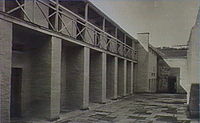Cascades Female Factory

Multi tool use
 Cascades Female Factory, circa 1914–41 | |
| Location | South Hobart, Tasmania |
|---|---|
| Coordinates | 42°53′38″S 147°17′57″E / 42.8938°S 147.2993°E / -42.8938; 147.2993Coordinates: 42°53′38″S 147°17′57″E / 42.8938°S 147.2993°E / -42.8938; 147.2993 |
| Status | UNESCO World Heritage Site |
| Security class | Former female factory, penal colony |
| Opened | 1828 |
| Closed | 1856 |
| Managed by | Port Arthur Historic Site Management Authority |
| Website | www.femalefactory.org.au |
UNESCO World Heritage Site | |
| Type | Cultural |
| Criteria | iv, vi |
| Designated | 2010 (34th session) |
| Part of | Australian Convict Sites |
| Reference no. | 1306 |
| State Party | |
| Region | Asia-Pacific |

Inside the sandstone wall remains of one of the yards, 2009.
The Cascades Female Factory, a former Australian workhouse for female convicts in the penal colony of Van Diemen's Land, is located in Hobart, Tasmania. Operational between 1828 and 1856, the factory is now one of the 11 sites that collectively comprise the Australian Convict Sites, listed on the World Heritage List by UNESCO.[1]
Collectively the Australian Convict Sites represent an exceptional example of the forced migration of convicts and an extraordinary example of global developments associated with punishment and reform. Representing the female experience, the Cascades Female Factory demonstrates how penal transportation was used to expand Britain's spheres of influence, as well as to punish and reform female convicts.
Now operational as a museum and tourist attraction, the site is managed by the Port Arthur Historic Site Management Authority.
Contents
1 History
2 See also
3 References
4 External links
History
Some rooms in the Macquarie Street Gaol served as a temporary Hobart "Female Factory" in the mid-1820s.[2] The Cascades Female Factory was purpose-built in 1828 and operated as a convict facility until 1856. It was intended to remove women convicts from the negative influences and temptations of Hobart, and also to protect society from what was seen as their immorality and corrupting influence. The Factory was located, however, in an area of damp swamp land, and with overcrowding, poor sanitation and inadequate food and clothes, there was a high rate of disease and mortality among its inmates.
The Cascades Female Factory is the only remaining female factory with extant remains which give a sense of what female factories were like. It is included on the Australian National Heritage List.[3] It was inscribed on the World Heritage list in July 2010, along with ten other Australian convict sites.[1]
Today the Cascades Female Factory Historic Site consists of three of the original five yards. It is open every day (except Christmas) and offers a range of tours.
See also
- Female Factory
References
^ ab "Australian Convict Sites". World Heritage Centre. UNESCO. Retrieved 29 February 2012..mw-parser-output cite.citation{font-style:inherit}.mw-parser-output .citation q{quotes:"""""""'""'"}.mw-parser-output .citation .cs1-lock-free a{background:url("//upload.wikimedia.org/wikipedia/commons/thumb/6/65/Lock-green.svg/9px-Lock-green.svg.png")no-repeat;background-position:right .1em center}.mw-parser-output .citation .cs1-lock-limited a,.mw-parser-output .citation .cs1-lock-registration a{background:url("//upload.wikimedia.org/wikipedia/commons/thumb/d/d6/Lock-gray-alt-2.svg/9px-Lock-gray-alt-2.svg.png")no-repeat;background-position:right .1em center}.mw-parser-output .citation .cs1-lock-subscription a{background:url("//upload.wikimedia.org/wikipedia/commons/thumb/a/aa/Lock-red-alt-2.svg/9px-Lock-red-alt-2.svg.png")no-repeat;background-position:right .1em center}.mw-parser-output .cs1-subscription,.mw-parser-output .cs1-registration{color:#555}.mw-parser-output .cs1-subscription span,.mw-parser-output .cs1-registration span{border-bottom:1px dotted;cursor:help}.mw-parser-output .cs1-ws-icon a{background:url("//upload.wikimedia.org/wikipedia/commons/thumb/4/4c/Wikisource-logo.svg/12px-Wikisource-logo.svg.png")no-repeat;background-position:right .1em center}.mw-parser-output code.cs1-code{color:inherit;background:inherit;border:inherit;padding:inherit}.mw-parser-output .cs1-hidden-error{display:none;font-size:100%}.mw-parser-output .cs1-visible-error{font-size:100%}.mw-parser-output .cs1-maint{display:none;color:#33aa33;margin-left:0.3em}.mw-parser-output .cs1-subscription,.mw-parser-output .cs1-registration,.mw-parser-output .cs1-format{font-size:95%}.mw-parser-output .cs1-kern-left,.mw-parser-output .cs1-kern-wl-left{padding-left:0.2em}.mw-parser-output .cs1-kern-right,.mw-parser-output .cs1-kern-wl-right{padding-right:0.2em}
^ Frost, Lucy (2006). "The Companion to Tasmanian History - Female Factories". The Companion to Tasmanian History. University of Tasmania. Retrieved 11 July 2014.
^ "Cascades Female Factory". National heritage places. Commonwealth of Australia: Department of Sustainability, Environment, Water, Population and Communities. 15 May 2008. Retrieved 29 April 2012.
External links
| Wikimedia Commons has media related to Cascades Female Factory. |
- Cascades Female Factory Historic Site website
- Tasmanian Heritage Council information package
- Old Photographs of Cascades' Female Factory, 1892
m I425H bc 0JLqtmiVfJw4dz08Uv,pphSAzy qD8mWSz7e,KyiqKGyEB4fb LVRNx6JhPJIB5K d 8xfV